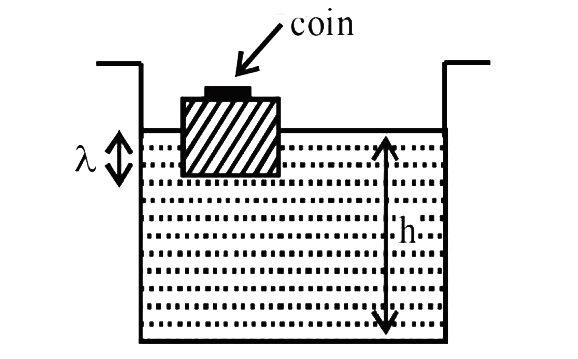When a coin placed in a bowl of water and seen from above, it appears :
raised from its position
below its position
at the same position
none of these
To solve the question of how a coin appears when placed in a bowl of water and viewed from above, we can follow these steps:
1. Understanding Refraction:
- When light travels from one medium to another (in this case, from water to air), it changes speed and direction. This phenomenon is known as refraction.
2. Identifying the Mediums:
- In our scenario, the coin is submerged in water (medium 1) and the observer is looking from air (medium 2). The density of water is greater than that of air.
3. Analyzing the Light Rays:
- Light rays coming from the coin travel upwards through the water and then into the air. As these rays move from a denser medium (water) to a less dense medium (air), they bend away from the normal line (an imaginary line perpendicular to the surface at the point of incidence).
4. Determining the Apparent Position:
- When we look at the coin from above, the light rays appear to originate from a point higher than the actual position of the coin due to the bending of light. If we extend the refracted rays backward, they seem to come from a point above the actual position of the coin.
5. Conclusion:
- Therefore, the coin appears to be raised from its actual position when viewed from above. This leads us to the correct answer, which is option 1: "It appears to be raised from its position."
Final Answer:
The coin appears to be raised from its position when viewed from above.
---
- When light travels from one medium to another (in this case, from water to air), it changes speed and direction. This phenomenon is known as refraction.
- In our scenario, the coin is submerged in water (medium 1) and the observer is looking from air (medium 2). The density of water is greater than that of air.
- Light rays coming from the coin travel upwards through the water and then into the air. As these rays move from a denser medium (water) to a less dense medium (air), they bend away from the normal line (an imaginary line perpendicular to the surface at the point of incidence).
- When we look at the coin from above, the light rays appear to originate from a point higher than the actual position of the coin due to the bending of light. If we extend the refracted rays backward, they seem to come from a point above the actual position of the coin.
- Therefore, the coin appears to be raised from its actual position when viewed from above. This leads us to the correct answer, which is option 1: "It appears to be raised from its position."
The coin appears to be raised from its position when viewed from above.
Topper's Solved these Questions
- LIGHT ENERGYBOOK - ICSECHAPTER - LIGHT ENERGYEXERCISE - EXERCISE-5.3 (Objective Type Questions) E. Match the statements in column A, with those in Column B.
1 Videos
- LIGHT ENERGYBOOK - ICSECHAPTER - LIGHT ENERGYEXERCISE - EXERCISE-5.3 (STUDY QUESTIONS)
6 Videos
- LIGHT ENERGYBOOK - ICSECHAPTER - LIGHT ENERGYEXERCISE - EXERCISE-5.3 (Objective Type Questions) C. Write .true.of .false. for the following statements :
5 Videos
- HEAT TRANSFER BOOK - ICSECHAPTER - HEAT TRANSFER EXERCISE - Picture Study
2 Videos
- MATTER BOOK - ICSECHAPTER - MATTER EXERCISE - THEME ASSIGNMENT
25 Videos
Similar Questions
Knowledge Check
A small air bubble in a glass block when seen from above appears to be raised because of :
Arefraction of lightBreflection of lightCreflection and refraction of lightDnone of the aboveWhen a plant cell is placed in pure water, it will
Abecome rigid because of turgor pressureBlose water and wiltCswell and burstDalter its cell wall composition so that it becomes impermeable to water
Consider an extended object immersed in water contained in a plane trough. When seen from close to the edge of the trough, the object looks distorted because.
View SolutionA wooden block, with a coin placed on its top, floats in water as shown in figure. The distance l and h are shown here. After some time the coin falls into water. Then

View SolutionA wooden block, with a coin placed on its top, floats in water as shown in figure. The distance l and h are shown here. After some time the coin falls into water. Then

View SolutionA balloon moving in a straight line passes vertically above two points A and B on a horizontal plane 1000ft apart. When above A it has an altitude of 60∘ as seen from B, when above B, 30∘ as seen from A. Find the distance from A at which it will strike the plane.
View SolutionA balloon moving in a straight line passes vertically above two points A and B on a horizontal plane 10ft apart. When above A the balloon has an angle of elevation of 60∘ as seen from B. When above B it has an angle of elevation of 45∘ as seen from A. The distance of B from the point C where it will touch the plane is
View SolutionWhy does a coin, placed on a card, drop into the tumbler when the card is rapidly flicked with a finger?
View Solution
